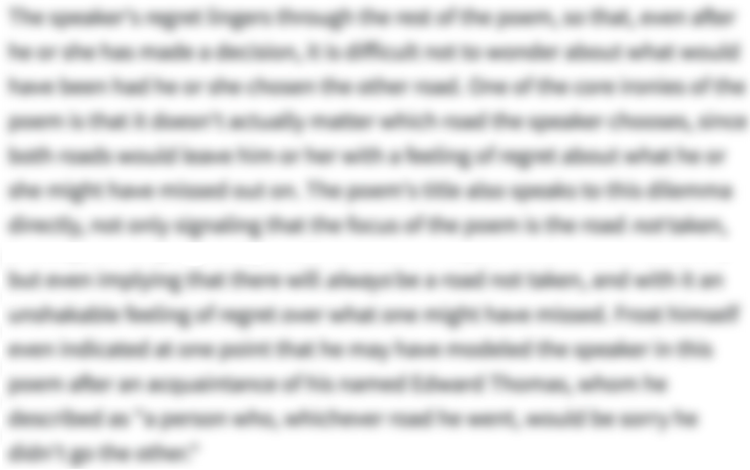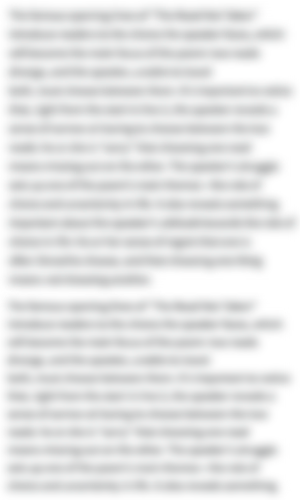The Full Text of “I’m Nobody! Who are you?”
1I’m Nobody! Who are you?
2Are you – Nobody – too?
3Then there’s a pair of us!
4Don’t tell! they’d advertise – you know!
5How dreary – to be – Somebody!
6How public – like a Frog –
7To tell one’s name – the livelong June –
8To an admiring Bog!
-
“I’m Nobody! Who are you?” Introduction
-
"I'm Nobody! Who are you?" is a short poem by American poet, Emily Dickinson, who wrote during the mid-19th century (though most of her poems were not published until the 1890s, after Dickinson had died). In the poem, a speaker introduces themselves—perhaps to the reader—as "Nobody," before excitedly realizing that the addressee is "Nobody" too. Paradoxically, this hints at a community of "Nobodies" out there. These people just don't make as much noise as all the "Somebodies," who crave attention and admiration. The poem, then, calls out to its readers to say that being humble, withdrawn, shy, or private is just fine. In fact, such a way of life has many virtues of its own. The poem is one of a number of Dickinson poems that questions the value of public admiration—something which eluded Dickinson in her own lifetime.
-
-
“I’m Nobody! Who are you?” Summary
-
The poem begins with an introduction from the speaker, who announces themselves as “Nobody!” They ask the identity of the addressee—which could be the reader—and if they’re "Nobody" too. Presumably learning that the addressee is "Nobody" too, the speaker expresses that together they make a “pair” of “Nobodies.” The speaker instructs the addressee not to tell anyone about this, because other people would make a fuss—which, the speaker implies, is something the addressee already knows.
The speaker then talks about how boring it would be to be a “Somebody.” It would leave nothing private. The speaker likens being a somebody to being a frog.“Somebodies” spend their time talking themselves up to anyone who will give them attention and admire them, comparable to frogs making their noises in a swamp.
-
-
“I’m Nobody! Who are you?” Themes
-
Anonymity and Solitude
"I'm Nobody! Who Are You?” is a short but powerful poem that questions the need for attention, seeking instead to highlight the virtues of anonymity and isolation. In essence, it is a poem in praise of quiet, individual contemplation—the kind represented by Dickinson and her poetry itself. Indeed, though they may never meet, those individuals who choose to be “Nobodies” over “Somebodies” paradoxically form a subtle but powerful community. The poem strives to say that it’s okay to be withdrawn, and that people aren’t necessarily alone in feeling like they want to keep themselves to themselves.
Note how the poem opens with an oxymoron: the speaker introduces themselves just like someone would in real life—by saying their name—except the speaker calls themselves "Nobody." The capitalization of this word subverts the typical social introduction, because the speaker isn’t trying to cement their identity in someone else's mind. Instead, they are joyfully and enthusiastically claiming that they are "Nobody!" In other words, the speaker's name or identity is the absence of a name or identity. This is a proclamation, encouraging others to feel that it’s okay to be "nobody too." From the beginning, then, it's clear that there's nothing wrong with or shameful about being nobody. (This could also relate specifically to Dickinson's acceptance that her poems would not find a wider audience during her lifetime.)
Not only is being a "nobody" perfectly okay, but it’s actually something of a badge of honor. In assuming that someone reading the poem will recognize themselves as a "nobody too," the speaker then expresses firm solidarity with them—which, ironically, means the speaker isn't really alone. Though some people might not want to draw attention to themselves or feel the need to network with their contemporaries, these people still form a kind of community. It exists, says the poem, and should be celebrated.
The speaker knows that this thought goes against the status quo, and thus presents it as a kind of secret, imploring the reader not to tell the "somebodies" about the existence of what's essentially an underground network of "nobodies." Those "somebodies"—people who care about fame and recognition—would tell others about the "nobodies" (that is, they'd "advertise" their existence), which, in turn, would transform those "nobodies" into somebodies—the exact opposite of what the "nobodies" want!
In the second stanza, the speaker calls out being "somebody" as "dreary." That is, it’s not quiet, shy people who are boring—it’s those people who don’t have the inner resources to be by themselves. The implication is that these types of people are so preoccupied with singing their own name to the "admiring bog" all day that they miss something fundamental about being human. While it might be part of human nature to seek attention and socialization, it’s also just as important to know how to be alone, and to find self-worth that isn’t dependent on external approval.
With characteristic brevity and humor, then, Dickinson’s poem makes a bold point: it's okay—even powerful—to be anonymous. Indeed, in a world obsessed with social media and public perception, perhaps the poem is even more relevant now than at the time of writing.
- See where this theme is active in the poem.
-
-
Line-by-Line Explanation & Analysis of “I’m Nobody! Who are you?”
-
Lines 1-2
I’m Nobody! Who are you?
Are you – Nobody – too?The poem argues in favor of outsiders and criticizes people who depend on others' attention for approval. It sets up this premise immediately with its emphatic opening statement, in which the speaker introduces themselves with an oxymoron. The speaker refers to themselves as "Nobody," the capitalization of the word making it read as a proper noun (like a person's first name). Not only is the speaker "Nobody," but they're also enthusiastic to say so, as shown by the exclamation mark caesura in the middle of line 1.
In essence, this opening is a kind of parody. Overall, the poem questions those who are overly reliant on external approval—people whose lives are governed by garnering attention and being liked. This type of social behavior—at least from this poem's perspective—is a kind of performance, and the first line seems to deliberately mimic such behavior. It's almost like the opening remark of one businessperson meeting another for the first time, making sure that the other is under no illusion as to the first's identity. It echoes the language that two people might use when shaking hands and gives the impression that they're trying to impress each other. But while the line has the tone and insistence of a confident meeting, it is actually a deliberate expression of anonymity. That's why it's an oxymoron—you can't be "nobody" in the literal sense if you are a living, talking human being saying the word "nobody" out loud (or writing it on the page).
With that in mind, then, "nobody" already means something different from what it might mean in a sentence like "nobody was there." Whereas in that example, "nobody" denotes an absence (there were no people around), "Nobody" here does precisely the opposite—it announces someone's presence.
Following this proclamation, the speaker asks the reader—or an off-page addressee—who they are. In a way, this is a rhetorical question—the poem provides no answer in textual form, and whoever is on the receiving ends of the question can't answer. But of course, the rest of the poem undercuts this brilliantly by providing its own answers. This begins in the second line, with the speaker asking hesitantly whether the reader is a "nobody" too. The two caesurae in this line—the characteristic Dickinson dashes—create a sense of hesitation. This is important, because the poem overall is implying that most people are not willingly "Nobodies," but rather prefer to be "Somebodies." The speaker is so amazed to find another "Nobody" that the basic question ("Are you nobody too?") doesn't come easily—it's almost like the speaker is checking that this other "Nobody" is real.
The word "too," though small, is crucial. It speaks to a process of recognition, as the speaker realizes that he or she isn't the only "Nobody" in the world. Thematically speaking, these lines establish a sense of solidarity between two people, showing the reader how connection can occur without seeking the approval of others. This is the poem's central paradox: a community of people based on anonymity, who, by virtue of their shyness (or just personal preference) are unlikely to ever actually meet face-to-face. Dickinson's inability to find literary fame during her lifetime is also relevant. People who don't seek fame and attention, the poem seems to suggest already , still make an important contribution to humanity and are capable of living happy lives.
-
Lines 3-4
Then there’s a pair of us!
Don’t tell! they’d advertise – you know!

Unlock all 350 words of this analysis of Lines 3-4 of “I’m Nobody! Who are you?,” and get the Line-by-Line Analysis for every poem we cover.
Plus so much more...
Get LitCharts A+ -
Lines 5-6
How dreary – to be – Somebody!
How public – like a Frog -
Lines 7-8
To tell one’s name – the livelong June –
To an admiring Bog!
-
-
“I’m Nobody! Who are you?” Symbols
-
Frog
In the poem's only instance of figurative imagery, the speaker compares being a "Somebody" to being like a frog. This frog is a "public" creature, which refers to the fact that frogs announce their presence (essentially, "tell" their "names") via loud croaks, while all the other frogs around them do the same thing. This comparison suggests that "Somebodies," too, like to talk about themselves all the "livelong" day to other "Somebodies." The frog here represents how vacuous and, frankly, annoying this tendency can be.
This isn't really meant as an insult to frogs. The point is that these sounds are loud, grating, and uncouth (no one would characterize croaks as being sophisticated or lovely). A "bog" also isn't exactly a nice place to hang out—it's smelly and swampy, which makes being surrounded by "Somebodies" seem like a less than pleasant experience.
And of course, these frog noises all sound pretty much the same! So, for all that "Somebodies" want to be recognized as unique and special, the way in which they go about this actually makes them all quite mundane and similar. The noises made by "Somebodies," then, are being gently mocked here, with the comparison suggesting that, for all their bluster, they are ultimately vapid and meaningless.
- See where this symbol appears in the poem.
-
-
“I’m Nobody! Who are you?” Poetic Devices & Figurative Language
-
Anaphora
Anaphora occurs in the second stanza, both with the repeated "How" in lines 5 and 6 and with the repeated "To" in lines 7 and 8. To understand why anaphora is used here, it needs to be considered within the overall movement of the poem. The first stanza showed the speaker recognizing another "Nobody," speaking to this addressee in excited, hushed tones and imploring him or her not to tell anyone that the two have found each other. In other words, the first stanza develops the idea of being a "Nobody."
The second stanza, however, is like a mirror image of the first, discussing instead the idea of "Somebody" (which also helps define "Nobody"). Put generally, the speaker believes that it's better to be "Nobody" and that it's actually quite boring—"dreary"—to be "Somebody."
This is where the anaphora comes in—it helps create this sense of boredom and weariness, as though the speaker can hardly put up with the idea of another "Somebody" in the world. The two sets of lines in the second stanza feel repetitive and predictable—exactly the qualities that the speaker thinks "Somebodies" embody. The anaphora also makes it sound as though the speaker offers just two negative "Somebody" traits from a long list—the speaker could, if they wanted, name more flaws than dreariness and being public. Finally, the anaphora has an insistent sound to it, which mimics the way in which "Somebodies" try to impose their identity on the world in order to gain admiration and attention.
- See where this poetic device appears in the poem.
-
Assonance


Unlock all 212 words of this analysis of Assonance in “I’m Nobody! Who are you?,” and get the poetic device analyses for every poem we cover.
Plus so much more...
Get LitCharts A+ -
Caesura
-
Oxymoron
-
Paradox
-
Rhetorical Question
-
Simile
-
Consonance
-
-
“I’m Nobody! Who are you?” Vocabulary
Select any word below to get its definition in the context of the poem. The words are listed in the order in which they appear in the poem.
- Advertise
- Livelong
- Bog
Advertise-
Here, this means something more like "publicize." (As in, the secret about being "Nobody" would be out if the addressee did "tell.") It's not meant in the sense of actual commercial advertising.
- See where this vocabulary word appears in the poem.
-
Form, Meter, & Rhyme Scheme of “I’m Nobody! Who are you?”
-
Form
"I'm Nobody! Who are you?" is a short poem made up of two stanzas, each of which is a quatrain. It's also a poem of two halves in the sense that each quatrain does something distinctly different. The first stanza sees the speaker reaching out to another person—perhaps the reader and/or all the other "Nobodies" in the world—and introducing themselves as "Nobody." This quatrain is a kind of two-way conversation of which the reader sees only one side. The speaker feels an affinity with the addressee, and, in hushed and excited tones, implores this second person to keep the"Nobody" status that the two share a secret. The first stanza, then, is about identity and solidarity.
The second stanza shifts the poem into a discussion about people who try to be "Somebody." By explaining some of the negative things about being a "Somebody," this stanza also makes it clearer what's good about being a "Nobody": being a "Nobody" is not dreary, public, or dependent on admiration. This quatrain also contains the poem's most overtly poetical moment, when the speaker uses a simile to liken "Somebodies" to noisy frogs.
-
Meter
The sound of the meter in "I'm Nobody! Who Are you?" is characteristic of Emily Dickinson's poetry more generally. Overall, the poem is generally iambic (meaning it follows an unstressed-stressed, or da DUM, syllable pattern.) We could classify it as going back and forth between iambic tetrameter and iambic trimeter, but it never quite settles into something that feels especially regular, partly because of metrical variations and partly due to the use of punctuation.
There is an awkwardness to the meter in the first line that pokes fun at the enthusiasm with which "Somebodies"—people who crave attention and admiration—introduce themselves. The exclamation mark halfway through the line makes the most probable scansion seem to be:
I'm Nobody! Who are you?
Looked at this way, the line stresses the "no-ness" of the introduction. That is, though the line sounds like somebody telling someone else their name, the stress on "no" actually highlights the fact the speaker doesn't have a name—or if they do, they feel no need to reveal it.
Throughout the poem, all of the lines either have three or four stresses in them. The most regular-sounding line is line 7, which is iambic tetrameter that reads smoothly despite the dash:
To tell | one's name | – the live- | long June –
The meter in this line helps create a sense of plodding boredom, which is what the speaker perceives in the lives of "Somebodies." In contrast, then, the variability of the meter in the other lines highlights how being a "Nobody" is actually more fun and interesting than being a "Somebody."
-
Rhyme Scheme
The poem uses rhyme, but overall, it's too irregular to call it a scheme. The first two lines rhyme, and lines 6 and 8 form a rhymed pair as well.
These two moments are significant, though. The first pair—you/too—helps establish the speaker's sense of excitement and disbelief that they have found a "you" [that is, another person] who is also a "Nobody." It shows a move towards kinship between the "I" and the "you"—which is what is required for there to be a "pair." Indeed, these two rhymed works make a pair, therefore underscoring this sudden, unlikely, and exciting pairing. "Too" shows that there is now more than "one," in the sense that "too" means "as well." So the existence of a "you" creates a "too" (and a two!) that shows that the speaker isn't alone in being "Nobody."
The other rhyming pair is frog/bog. These make an obvious pair because the latter word describes the habitat of the first: frogs—or the frogs the poem refers to, at least—live in swampy bogs. This rhyme subtly reminds the reader that just as frogs have to live in their bogs, so too do "Somebodies" have to live in unappealing crowds full of other people competing for recognition.
-
-
“I’m Nobody! Who are you?” Speaker
-
The speaker in this poem is not specified, but identifies themselves as "Nobody." They see being nobody—which perhaps means being private and humble—as preferable to being "Somebody." "Somebodies," the speaker says, live boring lives in search of attention and admiration. Of course, there are significant parallels between the speaker's position and Dickinson's own life story and ideas. She sensed the worth of her poems, but quickly realized that they wouldn't find an audience during her lifetime. This was in part because she was a woman, but also because of the startling originality of her writing. In short, she knew she would "Nobody" in the sense of finding fame and admiration, and part of this poem's aim is to legitimize the status of the outsider.
There's also a second speaker in the poem—but one whose voice the reader doesn't hear or see. In fact, it might even be the reader themselves! The speaker clearly gets a response to the poem's opening questions, with line 3 confirming that whoever the speaker is talking to is "Nobody" too. The beauty of the addressee's response being hidden is that the conversation between the poem and its audience essentially takes place every time the poem is read: anyone who identifies with what the speaker is saying can feel that they themselves are the second "Nobody" conversing with the speaker.
-
-
“I’m Nobody! Who are you?” Setting
-
This poem is a kind of conversation, without a specified place or time (or even addressee). The reader's only clue as to setting—which is not something the poem relies heavily upon—is in the tone of the speaker. The speaker is clearly surprised to stumble across another "Nobody," and the exclamation marks and dashes create a sense of hushed excitement around this discovery. Excitement because of the new discovery, and hushedness because to make too much noise about it would let the secret out. It seems, then, that this poem is taking place in a society where "Somebodies" are the norm; it's as if the world of the poem is one that's generally not welcoming to "Nobodies" who aren't interested in talking about themselves.
In the second stanza, the poem makes mention of a "bog" where "a Frog" might live. But this is just in service of the simile—which compares "Somebodies" to frogs—rather than a specific setting. The second stanza, then, maintains the conversational setting of the first and also adds just a bit more detail about the world of the poem, implying that the society the speaker lives in may be dull and unpleasant, just like a bog.
-
-
Literary and Historical Context of “I’m Nobody! Who are you?”
Literary Context
Emily Dickinson (1830-1886), one of the world's most influential and beloved poets, might never have been known at all. During her lifetime, she published only a handful of the nearly 1,800 poems she composed, preferring to keep much of her writing private. If Dickinson's sister Lavinia hadn't discovered a trunkful of poetry hidden in Dickinson's bedroom after her death, that poetry could have been lost.
Perhaps it's partly because of her separation from the literary mainstream that Dickinson's poetry is so idiosyncratic and distinctive. While her interest in the power of nature and the workings of the soul mark her as a voice of the American Romantic movement, her work didn't sound like anyone else's. Combining the common meter rhythms of hymns with strange, spiky, dash-riddled diction, Dickinson's poems often plumbed eerie psychological depths over the course of only a few lines.
Dickinson was inspired both by contemporary American Transcendentalists—like Emerson, whose essays on self-reliance she deeply admired—and by the work of earlier English writers like Charlotte Brontë and William Wordsworth. All these writers shared an interest in the lives of ordinary people and struggled for inner freedom in a 19th-century world that often demanded conformity.
Historical Context
Emily Dickinson lived in small-town Amherst, Massachusetts all her life. She grew up in a strict Protestant environment that placed great emphasis on religious rules and social codes; in fact, her family line can be traced back to the 16th-century Puritan settler John Winthrop. Though she ultimately rejected organized religion, her poems remain preoccupied with theological concerns (including the existence of an afterlife and competing ideas about the ways in which people ought to serve God). Dickinson's religious upbringing also shows itself in the hymn-like tones and rhythms of her poetry.
Dickinson wrote most of her poetry during the American Civil war, which ran from 1861 to 1865. She was firmly on the Union side of that bloody conflict; in one of her letters, she writes with delight about the ignominious defeat of Confederate president Jefferson Davis, who was reportedly trying to make his escape disguised in a woman's skirt when he was finally captured. She even contributed three anonymous poems—some of only a handful she published during her lifetime—to a fundraising magazine in support of the Union army.
However, Dickinson rarely addressed the political world around her directly in her poetry, preferring either to write about her immediate surroundings or to take a much wider philosophical perspective. And by all accounts, Dickinson's life was extremely unusual for the time. Most women were expected to marry and have children, but she never did; in fact, towards the end of her life, she barely spoke to anyone but a small circle of close friends and family. She spent most of her time shut up in her room, relatively immune to what was taking place outside in the wider world.
-
More “I’m Nobody! Who are you?” Resources
-
External Resources
-
A Reading of the Poem — A reading from a play about Dickinson (which uses a slightly different version of the poem).
-
Understanding Dickinson's Use of Meter — A valuable discussion of Emily Dickinson's use of meter in her poetry.
-
Learn More About Dickinson's Life and Poetry — Experts talk about Emily Dickinson's life and work on the BBC's In Our Time podcast/radio show.
-
Cynthia Nixon Interview — A clip in which actor Cynthia Nixon discusses playing Emily Dickinson in the film A Quiet Passion.
-
Educational Resources — Resources for students about Dickinson provided by the Emily Dickinson museum (which is situated in her old house).
-
More of Dickinson's Poems — Check out more of Emily Dickinson work.
-
-
LitCharts on Other Poems by Emily Dickinson
-










